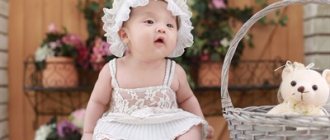Baby calendar
The seasons are easy to distinguish from each other. Each season brings with it an important, interesting event. For example, birthdays, family dates and holidays, New Year, so beloved by children. Start making a personal calendar with your child:
- In winter, Santa Claus comes to the baby with gifts, dad brings a Christmas tree, and the baby dresses it up.
- In the summer, the whole family goes to the sea: your parents are on vacation, mom and dad are both at home, and you have fun together in nature.
- In autumn it rains and you can run through puddles in boots, while older children go to school with backpacks.
- In spring, the snow melts and the first flowers bloom, the leaves on the trees become more and more green right before our eyes.
With your help, your child notices and learns the names of the seasons. Months are more difficult. Not only is it so difficult to remember their names, you also need to learn the order of how they run after each other, like a round dance.
Methods for remembering months and seasons of the year
When should a baby start getting acquainted with the outside world? It is best to start a detailed acquaintance with the months when the child starts talking. Now each of your walks becomes not only entertainment, but also an activity. But how to teach your child the months of the year and the names of the seasons is not difficult; start implementing the techniques from this article right now:
- Play games.
- Create drawings.
- Learn and compose poems, riddles, fairy tales, stories, cartoons.
- Use associations and memorable dates.
- Pay attention to the sensations.
- Explain why seasonal clothing is worn.
- Link your baby's favorite holidays to months.
- Contemplate nature on walks, observing with your baby all the changes that occur.
How to teach your child the months of the year
Fedorova Anna Alexandrovna
How to teach your child the months of the year
Where to start learning
a child to study the is knowledge about the seasons themselves , the ability to navigate them. start introducing the seasons with the year . To do this, there are a large number of illustrations that need to be shown to the child and told about what is depicted there. your child per year . 2-3 sentences that more vividly describe the time of year . You shouldn't show all the seasons at the same time . One day you show a picture of autumn several times a day for 5 minutes, the next day a picture of the next season .
kak-vyuchit-s-rebenkom-mesyacy-goda.jpgMoments worth paying attention to
The child should be interested. If he doesn’t want to, he’s distracted, put the picture aside for later, he won’t remember anything anyway, but will only become more irritable. The baby should not have any physiological needs. He should be full, not want to go to the toilet and sleep. The best way to remember all the signs of each season is observation . Lively and bright, where you can touch, listen, smell and take with you. After all, children of early preschool age learn tactilely, through touch and sensation.
Signs of the seasons
And now in more detail about the signs of each season that children should pay attention to. It is believed that learning must begin strictly in winter; it is brighter, more expressive and easier for children to remember. Winter is the Snow Kingdom. It is necessary to give the child the opportunity to tactilely explore the snow. Take it in your hands, try to make a ball out of it or scatter it in a thin layer on the ground. Tell that the snow is cold and wet. Help the child build a semantic chain himself: winter-snow-cold and wet. At an older age, your child about winter holidays and winter entertainment.
Spring is the time when everything wakes up. Show the first leaves on the trees, buds. Listen with your child to how he “sings”
Creek.
Tell them that birds are returning from warmer climes, introduce them using illustrations and poems, cartoons with animals waking up after hibernation. Summer - here the child will know that this is a vacation with his parents or a fun time with his grandmother. But it should also be noted that only in the summer do a large number of fruits and vegetables that are useful and necessary for the body ripen. In summer, the nights become shorter and the days longer. You can pay attention to green trees and flowers. Watch the bugs and butterflies. Autumn is the most beautiful time of the year , when the leaves that have changed color fall from the trees in some kind of dance. With your child, you can collect available materials: cones, chestnuts, leaves and create a craft together. You can collect the most memorable leaves during walks: red, green and yellow and create a herbarium.
Tell us that in the fall it’s already getting colder, it’s getting dark earlier, and the birds are flying to warmer climes for the winter. kak-vyuchit-s-rebenkom-mesyacy-goda.jpg
At the age of 2-3 years, a child should have a good knowledge of the seasons , know their signs and navigate the sequence. By the age of 5, a child can be introduced to the months and taught to pronounce them correctly.
Exercises, methods, techniques
Currently, there are a large number of games and aids for studying months . It is recommended to use presentations. This is an excellent option: it contains a large number of pictures that consistently introduce the child of year and the signs of each month . When choosing illustrations, remember that they should be bright and colorful. Should not be cluttered with extraneous parts and should be fit for purpose. If you need to talk about people’s work in the fall, then the picture should be appropriate: a field, a combine harvester and working people. The best form of teaching children in preschool age is play. Mini-scenes would be an excellent option. Here you can either play out the situation, or simply arrange for the arrival of Aunt Owl, who wants to solve riddles, or Dunno came and fell on the way, breaking the picture, you need to help. And the picture can serve as an illustration of the season , collect and tell what is depicted in the picture. You can organize an art evening, offer to draw a season , a person in certain clothes and find out when they wear a jacket, fur coat or T-shirt and shorts. Also, do not forget about reading fairy tales, poems, riddles and proverbs. An excellent option would be the famous book “365 Fairy Tales”
.
It contains a large number of illustrations for every season and day . There are also books “Seasons
” and “
Studying the calendar”
, which will help you cope with the study of the
seasons . These are excellent exercises for a child , they develop the child’s well, help put all the information in its place and are a great pastime for the whole family.
Game-based learning
The most important principle for obtaining new information for preschool children is play. If a child is interested , he will remember a large amount of new material: educational and colorful.
kak-vyuchit-s-rebenkom-mesyacy-goda.jpg
On the Internet there is a very fascinating and useful cartoon “Auntie Owl”
.
It will help your child find answers to a large number of questions. But you should remember that you don’t need to rashly let your child watch a cartoon and think that the problem has been solved, you need to sit down next to him and talk. So, the child is oriented in the signs of each season and has reached the required age (4.5
years ) to become familiar with
the months . It should be said that each season is divided into three months . An excellent option here would be nature calendars, where each time is divided into three months . You can either make a calendar yourself or purchase it at any store. Each month has its own picture , which is strictly associated with it. It must be made clear that the flowers bloom in May and the harvest begins in September. In the future, the child , looking at the picture, will name the month . You can conduct an observation. Choose an object outside the window for yourself and watch it for all 12 months , noting what changes occur. Reading fairy tales will also help. The right choice would be the fairy tale “12
months ” , where each of them is introduced in detail.
Composing small quatrains with a child . There are a huge number of memorabilia about every season . You can learn songs that are associated with the seasons and months , such as “Three White Horses”
.
To check, you can use pictures of fables, where the artist mixed up something, let the child guess . Album for filling “
Seasons ” , where you need to insert a picture into the cell of the desired
month .
Instead of a conclusion
How quickly and correctly a child will remember the months and seasons , as well as navigate them, depends on the method of presenting new information. The more interesting it is presented, the more likely it is to be remembered.
kak-vyuchit-s-rebenkom-mesyacy-goda.jpg
Detailed description of methods. The child is 2 years old
Walks. Active, linguistic observation of nature can be taught from the age of 2. Every new day, focus your child’s attention on the weather, what season and month it is. Describe in words everything you find and feel today. Become a walking and talking encyclopedia for your child.
What is it for. The information will be stored subconsciously, that is, your baby will instinctively know the names of the months and what is connected with them, without specifically learning them. This long-term memory will help him later when you move on to educational games.
The child turned 3 years old. Educational games
There are special nature calendars, “Seasons” lotto and their digital analogues for children. Take 4 identical parts of a sheet, stick a picture on each, which will make it easier for your child to explain the difference between winter and summer. Label the pictures and place each card on an envelope to hold pictures of seasonal clothing, holiday cards, and other images. At five years old, you will replace these pictures with pictures with the names of the months. The top flap of the envelope should be cut off so that the cards are visible from it, and it is easy for the baby to get them with his fingers.
First you need to let your child remember the names of the seasons and what is connected with them. Discuss with him what you can do when there is snow, the sun is shining hot, and it is raining. At the same time, it is better to start learning the alphabet, and you can start mastering the months at 5 years old. Be patient, as it is quite difficult to get the names of the months and their sequence into your head. But, in anticipation of his fifth birthday, your child, having mastered the alphabet, will be able to more easily perceive information and structure it.
Consultation “Seasons. How to help your child remember"
Svetlana Klimashina
Consultation “Seasons. How to help your child remember"
Growing children need more and more knowledge about the world around them. This information does not necessarily relate to practical skills (reading, counting, cutting and gluing)
.
The change of seasons , months and days of the week - how to explain these processes, how to teach a child to easily remember the necessary information .
This training can begin very early; already at one and a half to two years old , you need to draw the child’s attention to the characteristic signs of each season.
We study the seasons and their features
Winter. This is definitely the kingdom of snow. Let your baby try the snow with his fingers - connect his tactile memory. Build a chain: winter means snow, and the snow is cold and white. Later, when the child grows up, you can add other signs associated with this season, talk about popular winter activities and holidays.
How to teach your child the seasons and months of the year
Download the image " Seasons "
Spring is a time of awakening . Draw the child’s attention to the hatching buds, let him touch young leaves and blades of grass. Tell us which birds fly back in the spring after wintering, which animals awaken from hibernation.
Summer - with this time of year, the baby will most likely associate a vacation with his beloved grandmother, or another option - with his parents at sea. Also focus on the fact that it is in the summer that fruits and berries so beloved by children ripen, that in the summer you can play outside for a long time, because the days are long and the nights are short.
Autumn. The time when the leaves fall and turn bright colors. Time to make the most interesting autumn crafts - from cones, chestnuts, berries and foliage. Crafts and applications made from autumn gifts of nature are easy to correlate with the autumn season. At the same time , pay attention to other characteristic signs of autumn: it becomes colder, it gets dark earlier, there are frosts in the mornings, and some birds fly south for the winter.
At the age of two to three years, a child should be able to clearly identify the seasons , their sequence, and the main signs.
A great option for learning about the seasons is a board game or presentation
The easiest way is to teach your child to determine the months based on existing knowledge about the seasons . To do this, you can make your own visual aid that will help you quickly teach your child the necessary material and consolidate his knowledge about the seasons .
For example: January - New Year holidays, July - swimming in the river or at sea, March - the first snowdrops and tulips, April - the birthday of a child (sister, grandmother)
etc. Try to make the pictures bright and
memorable . You can diversify the pictures with home photos that show the baby himself, while making sure that it is clearly visible what time of year is shown in the photo.
For the first lessons memorizing two to three months ; it is much more important that the child tries to remember how they are distributed according to the seasons , which belong to summer, which to winter.
Poems, riddles, fairy tales, cartoons, children's films
In the period from 3 to 5, the baby also receives information about the seasons and months from literature and television. There are many riddles and quatrains on this topic that can be easily learned by heart.
Winter.
Smoke is coming from the chimney. Glass is painted. Let's go sledding. We are not cold - we are warm.
Summer.
Summer is upon us again! It became hot and light. Barefoot feet run straight along the paths.
Spring.
A week of March will fly by, April will ring like drops, May will come to us in flowers after it, Our city will be flooded with sunshine.
Autumn.
If the leaves in the forest have turned yellow, If the blue birds have flown into the sky, If the cloud is gloomy or the rain is pouring, Everything outside the window is called autumn.
Good films were created back in Soviet times: “Twelve Months”, “Morozko”, “Three Nuts for Cinderella”, the film about spring “Snow Maiden”, which well shows the change of seasons and the melting of snow. Watch them with your child and talk about these moments. Even if your child watched a movie or cartoon himself, discuss with him what he liked most and what upset him, and what he would do. Pay special attention to the details of the seasons.
Child 5-6 years old
By the age of five, your child, as a rule, has already mastered the alphabet, clearly knows the difference between winter and spring, and even expresses his preferences for which season he likes most. Now is the time to explain to him the order in which the months go.
Association games
It's time to take 12 cards out of our envelopes and study them in detail. Ask your child to put the months in order and tell him what he remembers about them, when Christmas or grandma’s name day will be, what clothes people wear in January, when you go on vacation.
Making unusual watches
- Divide the thick cardboard circle into 4 parts. These will be sectors with images of the seasons. Divide each sector into 3 parts and write the names of the months.
- Attach the hands to your clock.
- Place the arrows in the right place.
- Every first number, change the direction of the arrow. Of course, it’s better to let the baby do it himself.
Now, seeing all the months at once every day, the child will intuitively remember their location. Pay his attention to the “Clock of the Seasons”. “What season of the year is it now? Is it autumn now, September?”
Don't forget about spiritual intimacy
Psychologists say that playing together, communicating, walking, doing crafts, and helping preschoolers in the kitchen and housework form warm memories that will save them in adulthood. While children are small, we don’t just teach them, we lay a strong foundation, deep roots that will not allow them to fall in difficult moments of life.
Don't worry if your child is slow to learn the names of the months and seasons. Arriving at school, he will easily consolidate this skill in the first year. From the age of six, you can start writing the date and month in your copybooks every day. Also, don't limit yourself to our recommendations. Each child is individual and if you decide that at the age of three it will be useful for him to see a clock with seasons, then try it, only you yourself will find the right key for your little one.
How can a preschooler remember the names and order of the months?
Dear parents, I am sharing with you a way to help your child remember the names and order of the months. By the time a child is enrolled in first grade, he should already know that there are 12 months in a year, their names, order, seasons, how many months there are in each season, which months belong to which season. I once found the method of memorization on the Internet; I made the manuals myself.
In school preparation classes, when we study this topic, I teach children in the following order:
- Let me tell you that there are 12 months in a year.
- We learn the names of the months (I usually use a ball game to reinforce them: we throw a ball to each other and name the months in order until they are completely consolidated). At this stage, if the child can read or at least knows the letters, I use a poster on which the months are arranged from top to bottom and highlighted in different colors depending on the time of year: blue for winter, green for spring, red for summer, brown for autumn. This will make it easier for the child to visually remember which months are united by seasons. So that the child does not get confused as to which month the year begins, I use the following mnemonic device: when I say “January,” I place intonation emphasis on the letter I and point to myself: “I am January.” I ask the child to repeat several times (the child also points to himself and says: “I am January”). If a child forgets the first month of the year, I suggest: I point to myself. In this case, the child quickly remembers.
- To better remember which months belong to which time of year, I use encrypted names of the months and the associations with which they are associated. So the winter months are encrypted in the word DYAF - December, January, February (opposite this word is a picture with a dog in the snow). We explain to the child: “A dog stands in the snow in winter and barks: “Dyaf-dyaf, dyaf-dyaf.” The spring months are encrypted in the word MAM - March, April, May (a picture with the 8th of March written on it). We ask the child: “When is Mother’s Day? Of course, March 8th. And such a holiday happens in the spring.” The names of the summer months are encrypted in the word IIA - June, July, August. We say: “Eeyore is a donkey from the cartoon about Winnie the Pooh. When did he lose his tail? - In summer". The names of the autumn months are encrypted in the word DREAM - September, October, November. We remind the child: “In autumn, nature goes to sleep” (opposite the word is a picture of a hedgehog going into hibernation).
After we have talked and repeated the above several times, I separately tell the child the encrypted word, and the child shows the picture and names the season. Then vice versa: I show the picture, and the child says the encrypted word and deciphers the full names of the months related to a given time of year. I pre-prepare cut pictures. It is also important to name randomly so that there is no mechanical memorization.
Let these pictures hang in a prominent place in your home. Periodically repeat this topic with your child while walking, standing in line at a store, or traveling on public transport, and I’m sure the child will remember it well. Visual memory is strongest in preschool age.
Learn in a fun and interesting way!











